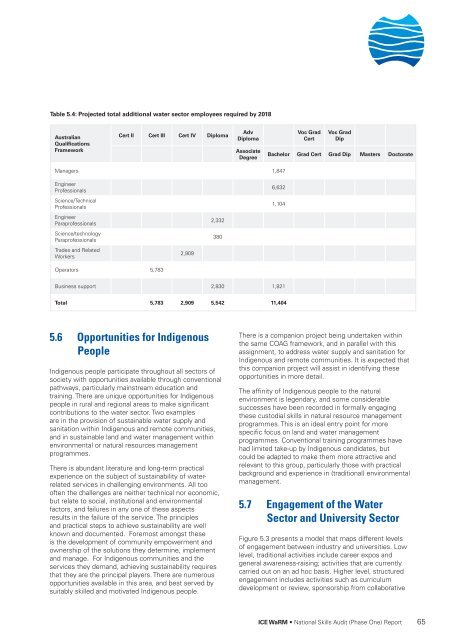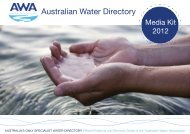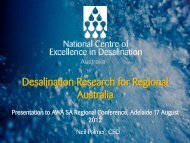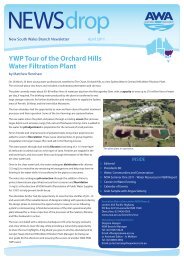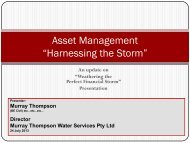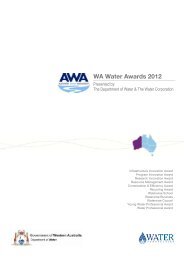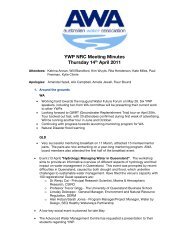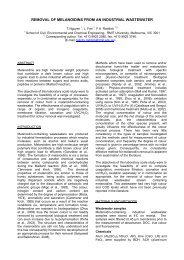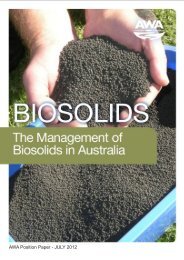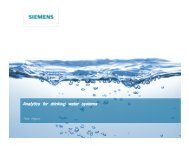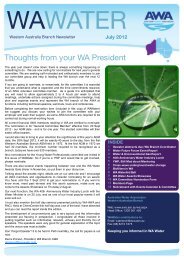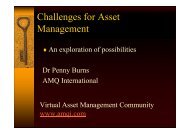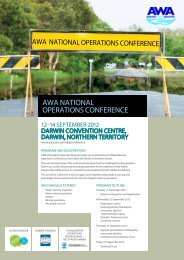National Water Skills Audit - Australian Water Association
National Water Skills Audit - Australian Water Association
National Water Skills Audit - Australian Water Association
- No tags were found...
Create successful ePaper yourself
Turn your PDF publications into a flip-book with our unique Google optimized e-Paper software.
Table 5.4: Projected total additional water sector employees required by 2018<strong>Australian</strong>QualificationsFrameworkCert II Cert III Cert IV DiplomaAdvDiplomaAssociateDegreeVoc GradCertVoc GradDipBachelor Grad Cert Grad Dip Masters DoctorateManagers 1,847EngineerProfessionalsScience/TechnicalProfessionals6,6321,104EngineerParaprofessionalsScience/technologyParaprofessionals2,332380Trades and RelatedWorkers2,909Operators 5,783Business support 2,830 1,821Total 5,783 2,909 5,542 11,4045.6 Opportunities for IndigenousPeopleIndigenous people participate throughout all sectors ofsociety with opportunities available through conventionalpathways, particularly mainstream education andtraining. There are unique opportunities for Indigenouspeople in rural and regional areas to make significantcontributions to the water sector. Two examplesare in the provision of sustainable water supply andsanitation within Indigenous and remote communities,and in sustainable land and water management withinenvironmental or natural resources managementprogrammes.There is abundant literature and long-term practicalexperience on the subject of sustainability of waterrelatedservices in challenging environments. All toooften the challenges are neither technical nor economic,but relate to social, institutional and environmentalfactors, and failures in any one of these aspectsresults in the failure of the service. The principlesand practical steps to achieve sustainability are wellknown and documented. Foremost amongst theseis the development of community empowerment andownership of the solutions they determine, implementand manage. For Indigenous communities and theservices they demand, achieving sustainability requiresthat they are the principal players. There are numerousopportunities available in this area, and best served bysuitably skilled and motivated Indigenous people.There is a companion project being undertaken withinthe same COAG framework, and in parallel with thisassignment, to address water supply and sanitation forIndigenous and remote communities. It is expected thatthis companion project will assist in identifying theseopportunities in more detail.The affinity of Indigenous people to the naturalenvironment is legendary, and some considerablesuccesses have been recorded in formally engagingthese custodial skills in natural resource managementprogrammes. This is an ideal entry point for morespecific focus on land and water managementprogrammes. Conventional training programmes havehad limited take-up by Indigenous candidates, butcould be adapted to make them more attractive andrelevant to this group, particularly those with practicalbackground and experience in (traditional) environmentalmanagement.5.7 Engagement of the <strong>Water</strong>Sector and University SectorFigure 5.3 presents a model that maps different levelsof engagement between industry and universities. Lowlevel, traditional activities include career expos andgeneral awareness-raising; activities that are currentlycarried out on an ad hoc basis. Higher level, structuredengagement includes activities such as curriculumdevelopment or review, sponsorship from collaborativeICE WaRM • <strong>National</strong> <strong>Skills</strong> <strong>Audit</strong> (Phase One) Report 65


